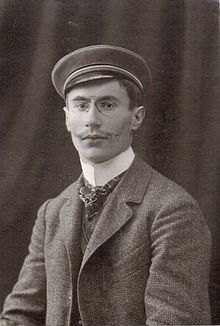Hermann Heuss
Hermann Heuss (born October 9, 1882 in Brackenheim ; † September 20, 1959 ) was a German architect and university professor .
Life
Hermann Heuss grew up in Brackenheim, his brother was Theodor Heuss . When he was seven years old, the family moved to Heilbronn due to a transfer of his father Ludwig Heuss .
Hermann Heuss studied architecture at the Technical University of Stuttgart and at the Technical University of Charlottenburg . During his studies in Stuttgart he joined the Alemannia Stuttgart fraternity in 1902 , of which he was a member until 1935. In 1912 he passed the second state examination and then worked as a government master builder ( assessor ) in the state building administration. During the First World War he worked at Krupp AG in Essen . In 1923, he was with a work on the castle and city building history of the former Hohenlohe residences at the Technical University of Stuttgart doctorate .
From 1919 he taught at the State Academy of Technology Chemnitz specialist construction . After the Second World War he became head of the successor institution, the Chemnitz Civil Engineering School . But since his brother Theodor Heuss was chairman of the FDP in the Federal Republic of Germany and was elected Federal President in September 1949 , the organs in the Soviet Zone began to monitor Hermann Heuss. In the same year he moved to the Federal Republic of Germany and founded an architecture office in Stuttgart-Degerloch .
Hermann Heuss died in 1959 after a car accident.
buildings
- Landhaus Müller-Isenburg, Chemnitz
Fonts
- Architecture and nature, two kinds of will to form. In: Die Form, Vol. 3, 1928, pp. 88–90 ( digitized version ).
- Contemplative city trips. Saxony-Thuringia. Berlin 1932.
- Hohenloher Baroque and Braid. (Dissertation) Öhringen 1937.
literature
- Isolde Döbele-Cariesso: In the shadow of the famous brother. In: Heilbronn voice from October 9, 2007 ( online )
- Helge Dvorak: Biographical Lexicon of the German Burschenschaft. Volume II: Artists. Winter, Heidelberg 2018, ISBN 978-3-8253-6813-5 , pp. 329-330.
Individual evidence
- ↑ Willy Nolte : Fraternity members regular role. Berlin 1934, p. 196.
- ↑ Fig. In: Die Form, Vol. 3, 1928, p. 89 ( digitized version ).
| personal data | |
|---|---|
| SURNAME | Heuss, Hermann |
| BRIEF DESCRIPTION | German architect and university professor |
| DATE OF BIRTH | October 9, 1882 |
| PLACE OF BIRTH | Brackenheim |
| DATE OF DEATH | 20th September 1959 |
